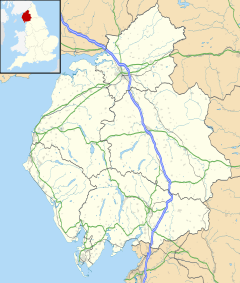Foulney Island facts for kids
Quick facts for kids Foulney Island |
|
|---|---|
| Population | 0 |
| OS grid reference | SD246640 |
| District |
|
| Shire county | |
| Region | |
| Country | England |
| Sovereign state | United Kingdom |
| Police | Cumbria |
| Fire | Cumbria |
| Ambulance | North West |
| EU Parliament | North West England |
Foulney Island is a small, flat island located off the coast of Cumbria, England. It's about 1 mile (1.6 km) southeast of Roa Island. This special island is part of the Islands of Furness in Morecambe Bay, northern England.
Foulney Island is mostly covered in grass and shingle (small stones). It covers an area of about 40 acres (16 hectares). In the past, it was sometimes called Fowle Island. The island is very low, only about 10 feet (3 meters) above high tide. During very high tides, parts of the island can even be covered by water. No one lives on Foulney Island permanently.
Contents
Connecting to Foulney Island
Foulney Island is connected to the mainland by a causeway. A causeway is a raised road or path built across wet ground or water. This causeway is made of shingle and rock. It was built a long time ago, during Victorian times, to help protect the area from the tides.
You can find the Foulney causeway by walking along the Roa Island causeway. It branches off halfway along the eastern side.
Foulney Island: A Special Bird Sanctuary
Foulney Island is a very important place for birds. It is a bird sanctuary, which means it's a safe place where birds can live and raise their young without being disturbed. The island is also part of a larger protected area called the South Walney & Piel Channel Flats Site of Special Scientific Interest (SSSI). This title means the area has special plants, animals, or geological features that need to be protected.
Managing the Sanctuary
Since 1974, the Cumbria Wildlife Trust has looked after Foulney Island. They work hard to keep it a safe home for birds. During the summer, when many birds are nesting, wardens (people who look after the sanctuary) are often on the island. They help make sure visitors don't accidentally disturb the nesting birds. It's important to avoid walking in the nesting areas during these times.
Birds You Might See
Many different types of birds have been seen at Foulney Island. Some of these include:
- Sandwich tern (sometimes)
- Little tern
- Arctic tern (Foulney is the only place in north-west England where these birds breed!)
- Common tern
- Roseate tern (these are quite rare)
- Oystercatcher
- Ringed plover
- Golden plover
- Grey plover
- Brent goose
- Red-breasted merganser
- Great crested grebe
- Common scoter
- Redshank
- Meadow pipit
- Eider duck
- Dunlin
- Knot
- Sanderling
- Curlew
- Eurasian whimbrel
- Godwit
Visiting Foulney Island
If you want to visit Foulney Island, you'll need to walk about a mile along the causeway. It's a nice walk, but there are some important rules to remember to keep the birds safe and yourself too.
Safety Tips for Visitors
- No Dogs: Please do not bring dogs to Foulney Island. Dogs, even well-behaved ones, can scare or harm nesting birds and their eggs.
- Stay Away from Nesting Areas: During the bird breeding season (usually spring and summer), it's very important to avoid the nesting grounds. The wardens can tell you where these areas are.
- Be Aware of the Tides: Because the island is low-lying and connected by a tidal causeway, always check the tide times before you go. You don't want to get stuck or caught by rising water.
Popular Activities Near Foulney
In recent years, the area around Foulney Island has become popular for collecting shellfish like cockles and mussels. There have been some worries that too much collecting could harm the bird nesting sites.
The area is also a favorite spot for fishermen and windsurfers. It's a great place to enjoy the outdoors and see nature, as long as everyone respects the wildlife and follows safety guidelines. In 2004, there was a sad event where many cockle pickers lost their lives in Morecambe Bay. This made people worry more about safety in the area.


